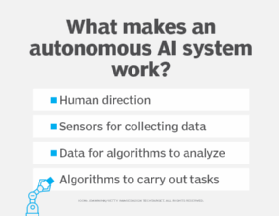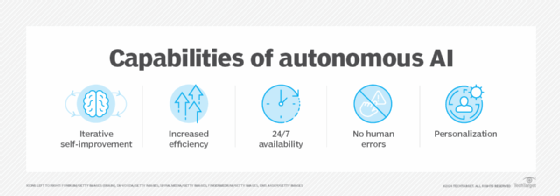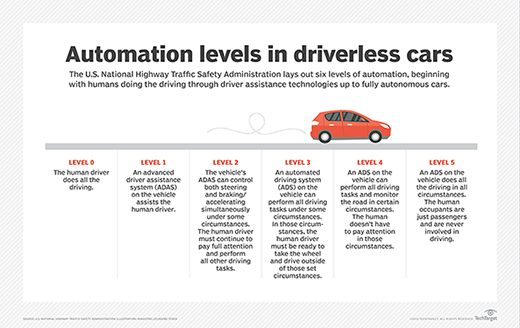What is autonomous AI?
Autonomous artificial intelligence (AI) is a branch of AI in which systems and tools are advanced enough to act with limited human oversight and involvement. The actions an autonomous AI system can perform range from automating basic, repetitive tasks to analyzing data sets. Autonomous AI takes artificial intelligence systems a step closer to AI as it's often depicted in works of fiction.
Through various components working together, an autonomous AI system brings advanced capabilities to businesses and other organizations. Some of these components, such as algorithms, are used to perform tasks like data analysis, while others, such as sensors, are strategically placed to collect the data needed for analysis.
Autonomous AI vs. general AI?
The term AI can encompass any type of AI tool or system that requires frequent human intervention. It also encompasses more advanced systems -- such as reinforcement learning, machine learning and deep learning platforms -- that can analyze vast data sets without much human intervention. Autonomous AI is one of the more advanced AI capabilities.
The term narrow AI is often used by experts to describe many current AI tools and systems that aren't fully capable of operating without human direction. The opposite would be artificial general intelligence (AGI), which is a theoretical notion that AI can be completely independent from human operators and able to exceed human capabilities in every way. Autonomous AI is neither, but it is a major step toward AGI.
This article is part of
What is GenAI? Generative AI explained
Autonomous AI's important features
An autonomous AI system requires the following three components:
- Physical devices to collect data. Sensors are often used for data collection. The term sensors can be broadly applied to cameras, microphones and similar devices that collect data from the outside world.
- The data itself. The data collected can be structured or unstructured because the algorithms used in autonomous systems are typically able to glean important insights from data regardless of the format.
- Algorithms. Computer algorithms are used to parse the data so the system can achieve its human-administered objective autonomously.
If these components work seamlessly together, an autonomous AI agent can carry out its own decision-making and tasks without human intervention. Autonomous AI agents are tools that take a simple objective from a human and formulate a plan to achieve that objective through a set of tasks and actions. Examples of autonomous agents include smart home devices, self-driving cars and software agents that complete tasks on users' computers, like Auto-GPT.

What are the benefits of autonomous AI?
The key benefit of autonomous AI is the ability to take on tasks and work that humans would have to do without them. Some additional benefits include the following:
- Iterative self-improvement. Other forms of narrow, or single-task, AI development require continuous training and fine-tuning of the AI system. This can mean tedious complex processes to ensure they continue functioning properly. Autonomous AI learns to improve on its own by repeating processes, learning iteratively. This relieves developers of the training burden.
- Efficiency. Many repetitive tasks divert time from more important and complex tasks requiring innovation and human thought. Businesses can automate these tasks using autonomous AI to improve efficiency. Autonomous AI systems also function without requiring 24/7 attention, further improving efficiency.
- No human errors. Autonomous AI systems handle tasks that have been error-prone when done by humans.
- Personalization. Autonomous AI can analyze data about consumers and provide personalized recommendations for them, which is especially useful for marketing teams.

What are the challenges posed by autonomous AI?
While the benefits of autonomous AI systems make them sound like flawless technology clearing the way to achieving AGI, there are challenges, such as the following:
- Cost considerations. Businesses with tight budgets, especially small ones, may find adopting autonomous AI technology impractical due to high costs.
- Regulation. Autonomous AI must be developed and used in compliance with laws and regulations focused on AI use, such as the Executive Order 14110 on Safe, Secure, and Trustworthy Development and Use of Artificial Intelligence,
- Bias. Organizations that develop or use autonomous AI must ensure algorithms don't have built-in biases, otherwise their outputs will be skewed and inaccurate.
- Security. When sensitive data is collected within autonomous AI systems, the security and privacy of that data must be ensured to prevent malicious actors from accessing it.
For more on generative AI, read the following articles:
Top generative AI benefits for business
Assessing different types of generative AI applications
Generative AI challenges that businesses should consider
Generative AI ethics: Biggest concerns
Generative AI landscape: Potential future trends
History of generative AI innovations spans 9 decades
How to detect AI-generated content
Generative models: VAEs, GANs, diffusion, transformers, NeRFs
GAN vs. transformer models: Comparing architectures and uses
Autonomous AI use cases
Various industries are capitalizing on the full potential of autonomous AI with pragmatic applications for autonomous AI. Industry use cases include the following:
- Healthcare. Autonomous AI can analyze patient data to produce important insights faster than humans and beyond what they're generally capable of.
- Manufacturing. Implementing autonomous AI systems, like robotic process automation, can streamline repetitive processes and free workers to focus on more important tasks.
- Customer service. Organizations can harness the power of autonomous AI and natural language processing to power chatbots that respond to customer needs. These tools can also offer personalized content, experiences and recommendations to customers.
- Financial services. Autonomous AI can use machine learning algorithms to predict the best investment strategies, based on existing data sets, within the financial sector.
- Automotive. Autonomous vehicles are an example of autonomous systems that use sensor hardware to detect the locations of surrounding objects and transmit that data to algorithms, which make decisions about vehicle actions and performance.

The autonomous revolution is here. Businesses are combining technologies to automate more human work. Learn about this push to build the autonomous enterprise.





